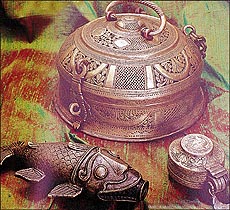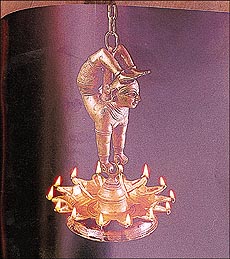A sojourn
with antiquity
Heritage
By
Suparna-Saraswati Puri
AT the foothills of the Western
Ghats, popularly known as the Sahyadris, on the eastern
slopes from where the Deccan plains start emerging from
an undulating hilly terrain, in a slight hollow on the
banks of the Mula and Mutha, is situated the city of
Pune, once described as the queen of the Deccan. The city
still retains this position by its old historical
associations, its picturesque surroundings and its
importance as a great cultural, social, educational and
political centre.
 Although, it is growing fast on all sides
everyday with its ever-increasing industrial and
commercial activity, one still smells in its refreshing
air the aroma of nostalgic memories of the not-too
distant past, when Pune enjoyed the status of the
principal seat of the Maratha edifice. Although, it is growing fast on all sides
everyday with its ever-increasing industrial and
commercial activity, one still smells in its refreshing
air the aroma of nostalgic memories of the not-too
distant past, when Pune enjoyed the status of the
principal seat of the Maratha edifice.
The majestic Shaniwar
Wada, Ambarkhana or the Lal Mahal, Vishrambagwada,
Parvati and a number of such other places temples and
movements remind us of the past glory and the rich
cultural heritage of the Maratha period.
In this city of the past
is located the fantastic wonder house, almost a
dreamworld, known as the Raja Dinkar Kelkar Museum,
created by a great little man, only 90-year young, Dr
Dinkar Gangadhar Kelkar.
In his own words Dr.
D.G. Kelkar wrote: "No other lady could have spend
fifty green years of her life travelling and wandering
all over the great country with a man so obsessed. A man
whose sole concern was to bring home all things crafted
and beautiful.That man remembers every journey, every
moment of the way, and bows his head with gratitude and
love to his dear wife, the late son Kamata, to whom he
owes everything."
What humility and
complete dedication towards one’s partner! This in
itself draws an art lover even closer to the life and
contribution of this common man of Pune. Born in 1896,
D.G. Kelkar belonged to a reasonably well-to-do Brahmin
family. Kelkar made his living by making spectacles and
repairing them in a tiny shack of his own in one of the
congested bazaars of Pune city. He had 13 children from
his marriage but by with terrible misfortune none of them
survived. even the one on whose name the museum was
(later) founded, Raja, lived only till the tender age of
12. It was party this tremendous loss that compelled
Dinkar Kelkar to do something for the sake of posterity
both for his child and the country he was so fond of. He
along with his wife left the comforts of a home and
travelled the length and breadth of
India, collecting any
kind of handicraft that came his way. It is this
obsessive and art-impulsive trait of Kelkar himself, that
is blatantly exhibited in this heritage ‘Shrine’.
 The museum is housed in Dr
Kelkar’s own ancestral residence which is a
four-storey haveli, with each of its floors
exhibiting a different range of Indian art and craft. The museum is housed in Dr
Kelkar’s own ancestral residence which is a
four-storey haveli, with each of its floors
exhibiting a different range of Indian art and craft.
Raja Dinkar Kelkar
Museum enjoys its international fame primarily due to the
superb craft section devoted to the Indian woman. The
founder and honorary director of the Museum, Dr. D.G.
Kelkar, with his boundless energy and enthusiasm for
artistic creativity, embarked on the creation of what can
only be stated as the most remarkable museum on Indian
woman in the country. The idea took definite shape after
Dr. Kelkar happened to meet Mrs. Indira Gandhi, who
openly expressed her appreciation of his relentless
efforts and the need for a place totally dedicated to the
traditional womenfolk of India and their lifestyle.
Hence, this section was added later to the rest of the
collection. a certain amount of sensitivity is felt while
viewing the objects as they have been divided in
accordance with the time of their use during the day.
Besides the women’s
section there is also a toy corner in one of the floors
of the museum showing paper masks, handicraft dolls and
puppets, clay, metal and terracota models of bullock
carts, soldiers, animals and birds. Seeing all these cute
little exhibits one is immediately transported back in
time to one’s childhood.
Next came the
exquisitely carved crafts from all types of wood, whether
it was the 10-15 feet doors decorated with five panel
work, or the tremendous collection of musical
instruments, or huge statues of mythical characters from
ancient Indian legends — all were completely
enchanting to the viewer’s eye. And last but surely
not the least was the entire floor on ancient Indian
iconography. The most unusual postures of some of the
deities such as Vishnu and Ganesha were
really amazing look at. Few of these icons had eyes made
from uncut precious stones such as ruby. The floor also
had the lamp collection displayed beautifully. It had one
very curious looking exhibit called the poison lamp made
of stone. The story goes that wherever the Peshwa sat for
his meals, he would first put a bit of the cooked food,
inside the lamp and if within a few seconds the colour of
the stone lamp changed, it meant that the Peshwa’s
meal had been poisoned. This test could also specify the
animal whose venom had been used in poisoning the meal.
Indeed, a remarkable vigilance technique on the part of
the medieval Deccan rulers!
Currently, however, the
museum has showcased only one-tenth of the real
collection made by Kelkar, due to paucity of space. A
proposal has been made to the government of Maharashtra
for providing an area of 10 acres so as to do justice to
the founding-father’s efforts in building a heritage
centre. Dr. Kelkar possessed a multi-faceted personality
with literary learnings.
Dr Kelkar was awarded a
Padmashree by the Government of India and a D.Litt. from
the University of Poona. However, for us art lovers, his
name undoubtedly occupies a proud place in the annals of
culture and tradition of India.
|

